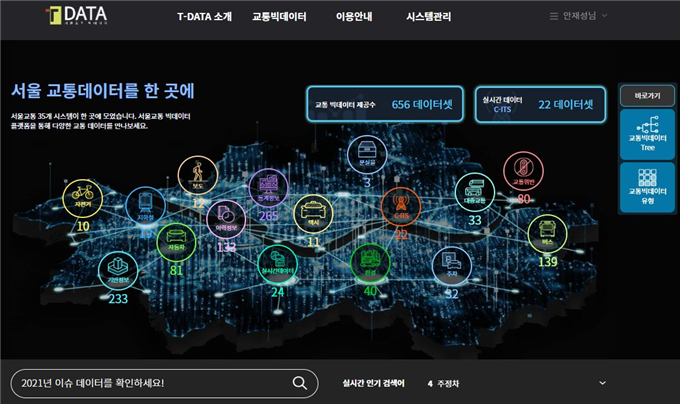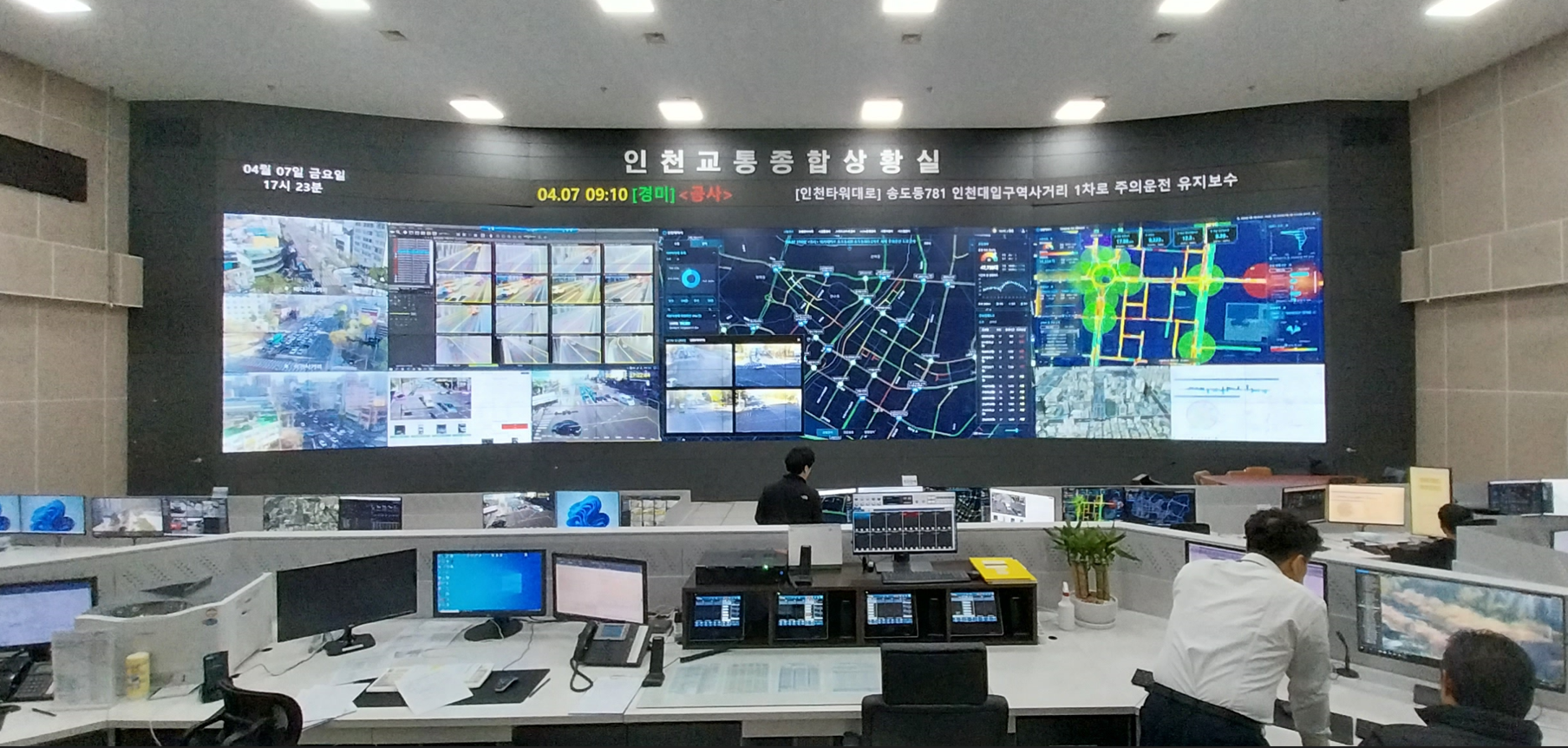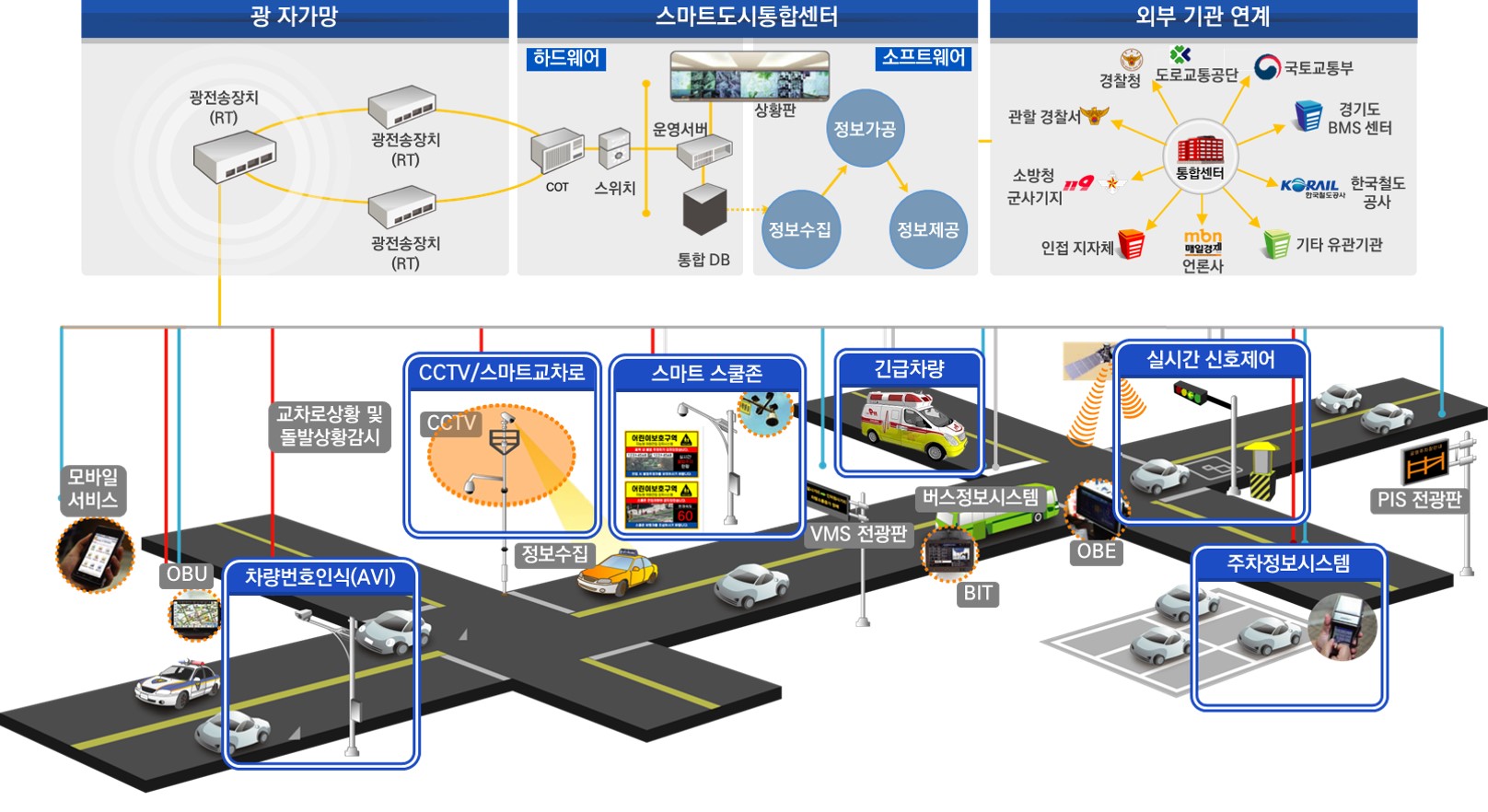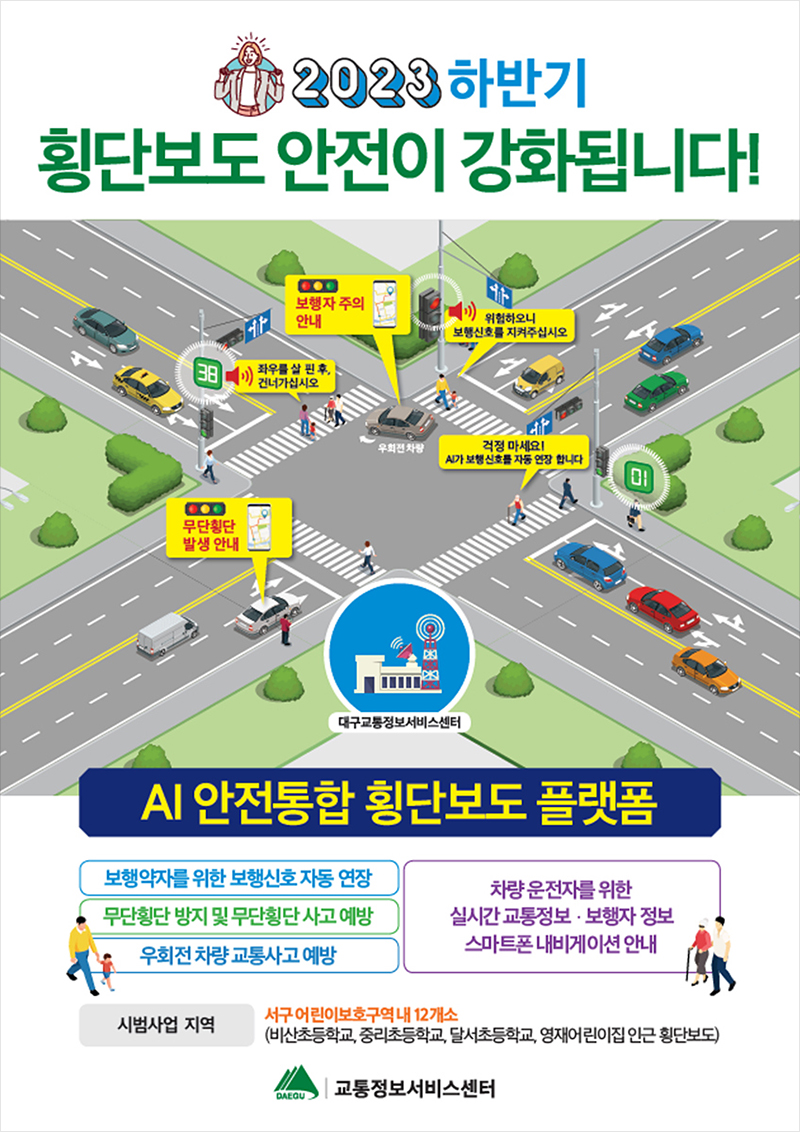서울시는 자율주행 및 교통변화에 선제적으로 대응할 수 있는 V2X 기반 첨단 시설을 운영하고, 인천, 안양 등 다양한 도시들은 시민의 안전을 도모할 수 있는 스마트교차로와 횡단보도 등 ITS 기반 시설을 적극적으로 도입, 활용하고 있다.
어린이·노인보호구역 등 교통사고 방지 교통안전 강화
최적 신호운영체계 적용…신속·정확한 교통정보 제공
지능형 교통 체계(ITS)와 차세대 기술인 C-ITS가 교통 혼잡 해소와 시민들의 안전, 두 마리 토끼를 동시에 잡을 수 있는 기술로 주목받으면서 국내 많은 도시들이 각 지역에 맞는 ITS 및 C-ITS 시스템을 도입하고 있다.
ITS와 C-ITS는 어린이, 노인을 포함한 보행자의 교통사고를 방지할 뿐만 아니라 교통시설물의 운영과 관리를 과학화·자동화해 차량 소통 흐름을 향상시키는 것은 물론 사고에 신속히 대응할 수 있으며 최적의 신호운영체계로 정확한 교통정보를 제공해 교통체증도 완화시킬 수 있다.
서울시는 자율주행 및 교통변화에 선제적으로 대응할 수 있는 V2X 기반 첨단 시설을 운영하고, 인천, 안양 등 다양한 도시들은 시민의 안전을 도모할 수 있는 스마트교차로와 횡단보도 등 ITS 기반 시설을 적극적으로 도입, 활용하고 있다.
본 기사에서는 각 지역별 ITS와 C-ITS 도입 현황에 대해 자세히 알아본다.
■ 서울특별시
서울시는 지난해 10월 서울 C-ITS의 차세대 지능형 교통체계의 실시간 도로위험, 신호, 차량상태 등 정보를 공공데이터’와 ‘서울교통 빅데이터’ 포털을 통해 국내 최초 오픈API로 제공하고 있다.

▲서울교통 빅데이터 포털 메인화면 (그림 출처: 서울시)
도심 주요 교차로(788개소)의 교통신호 및 잔여시간 정보를 제공하며 2024년까지 4차로 이상 모든 교차로(3,660개소) 정보로 확대 예정이다.
서울C-ITS는 국토교통부와 함께 자율주행 및 교통변화에 선제적으로 대응할 수 있도록 V2X 기반 첨단 시설을 상암, 강남 등 도심 지역 그리고 중앙버스 전용차로를 운영하는 도로에 구축하여 운영 중이다.
‘교통신호정보’ 뿐만 아니라 1,700대(시내버스1,600대, 택시100대)의 차량에서 수집되는 교차로 위험정보, 보행자정보등 ‘도로위험정보’, 차량 위치나 급감가속 등 ‘차량정보’ 그리고 맵 데이터 등 기반정보도 제공한다.
서울시는 “오픈API 서비스를 통해 시민들이 실시간 C-ITS 데이터와 다른 교통 데이터를 융·복합한다면 운전자 편의와 교통안전을 도모할 수 있는 새로운 시스템이 연구·개발될 것으로 기대한다”고 전했다.
■ 인천광역시
인천시가 교통흐름 개선과 사고 예방을 위해 지능형교통체계(ITS)를 기반으로 한 국내 최고 수준의 교통종합상황실을 구축하고, 경찰청과 함께 운영에 들어갔다는 내용의 보도자료를 지난 4월 배포했다.
인천시는 지난 2021년 국토교통부 주관 ‘지능형 교통체계(ITS) 공모사업’에 최종 선정되어 국비를 포함해 약 249억 원을 투입해 ITS 구축을 마쳤다.
이는 교통체계에 정보통신기술을 접목시켜 교통시설물의 운영과 관리를 과학화·자동화해 차량 소통 흐름을 향상시키는 것은 물론 사고에 신속히 대응하기 위한 것이다.

▲인천 지능형 교통종합상황실 (사진 출처: 인천시)
인천시가 구축한 지능형교통정보체계(ITS)에는 △스마트교차로 시스템 구축 △디지털트윈 기반 교통상황관리 △첨단신호제어시스템 등 국내 최초의 첨단 시스템이 도입됐다.
인천형 긴급차량 우선신호’서비스를 구현하는 첨단신호제어시스템이다.
이 시스템은 긴급차량이 출동지부터 목적지까지 계속 녹색신호를 받을 수 있도록 제공하여 화재출동 뿐만 아니라, 중중외상환자 이송 시에도 권역외상센터에 도착할 때까지 녹색신호를 제공해 빠르게 도착할 수 있도록 한다.
■ 안양시
안양시는 교통, 방범, 재난재해, 환경 등 설치 목적에 따라 부서별로 분산된 CCTV 운영체계로는 돌발 및 긴급상황 발생시 신속·종합적인 대응 한계가 있다고 판단해 목적·분야별 CCTV를 ITS 플랫폼으로 연계하고 통합·관리하는 데에 주력해왔다.
2020년부터 2023년까지 ‘스마트시티 통합플랫폼 구축’, ‘ITS 확대사업’ 등 국토교통부 공모사업을 활용해 각 부서가 보유한 CCTV 등 안전 인프라를 연계, 디지털 플랫폼 통합사업을 추진했으며, 도시 내 사건·사고의 통합관리 기반을 마련했다.
 ▲
▲안양시 ITS 개념도 (그림 출처: 안양시)
특히, AI 기술을 접목해 ITS 운영 방식을 효율적으로 개선한 점, 설치 목적에 상관없이 CCTV 공동 대응으로 예산을 절감한 점 등은 지능형교통체계의 모범사례로 소개됐다.
안양시는 위를 토대로 ‘지능형교통체계의 공공서비스 역할 확대 발전 방안’을 제시해 지난 5월 경기도 시·군 지능형교통체계 우수사례 발표대회에서 최우수상 수상의 영예를 안았다.
■ 천안시
천안시는 ITS 현장기반 시설물을 본격적으로 구축한다고 7월 발표했다.
지난해 12월 ITS 구축사업 용역사로 선정된 엘지 유플러스 컨소시엄은 6월까지 현장 조사 후 시설물 구축을 위한 LED 바닥신호등, 전광판, 네트워크 장비 등 주요물품 구매를 완료했다.
이후 10월까지 번영로, 쌍용대로, 천안대로 등 주요도로 198개소에 스마트교차로, 스마트횡단보도, 노변기지국, 긴급차량 알림 전광판을 설치한다는 계획이다.
시설물은 다양한 센서 기반 융복합 검지체계 적용으로 실시간 교통량, 대기차량의 수 등을 수집해 장래 교통수요, 흐름을 시뮬레이션하고 빅데이터 시각화 구현으로 교통정책 분석 자료를 제공하게 될 전망이다.
스마트교차로는 주요 교차로에 영상 인식 카메라를 설치해 딥러닝 기술을 활용한 영상분석으로 실시간 통과 교통량과 차량종류, 점유율, 속도 등의 정보를 수집해 적정 신호운영 분석을 위한 정책적 근거를 마련하고 교통패턴 분석을 위한 수집자료를 제공한다.
스마트 횡단보도는 횡단보도 영역에 검지센서, 바닥신호등 등을 설치해 상황에 따른 보행신호시간 연장 및 시청각적 정보를 보행자에 전달하는 것으로, 유동인구가 많은 지점이나 어린이·노인보호구역 등 보행자교통사고 방지 및 교통안전을 강화할 것으로 기대된다.
구간 교통정보 수집장치는 교차로 내 설치돼 하이패스 단말 장착 차량 통과 정보를 수집해 신뢰도 높은 구간 소통정보 생성 및 도로전광표지 정보제공 시 활용된다.
■ 창원특례시
창원특례시는 지난해 10월 국토부 공모사업으로 선정되어 추진한 ‘2021~2022년 ITS 구축사업’을 완료했다고 밝혔다.
이번 사업은 지난 2020년 9월 국토부 국비지원 공모사업 선정으로 2021년부터 2개년에 걸쳐 국비 20억을 확보하여 추진한 사업으로, 2021년 4월 사업수행능력평가(PQ)로 실시설계업자 선정, 지난해 10월 공사 착공하여 2022년 준공하였다.
주요 시설물로 △교통정보를 실시간으로 관제할 수 있는 CCTV 20개소 △교통정체와 돌발사고 등 도로 교통상황을 제공하는 도로전광판(VMS) 8개소 △교차로 방향별 영상정보를 수집·분석하여 최적의 신호시스템을 구현하는 스마트교차로 10개소 △시 외곽 도로에 좌회전 차량이 있을 때만 자동 검지하여 좌회전을 부여하여 주도로 직진소통을 원활하게 하는 감응신호시스템 17개소 △골든타임 확보를 위한 긴급차량 우선신호시스템 1개소를 구축하였다.
.jpg) ▲
▲창원 감응신호 개념도 (그림 출처: 창원시)
창원시는 2023년 공모사업에서도 7억을 확보하는 등 4년(2020년~2023년) 연속 선정으로 '지능형교통시스템 구축사업'을 단계적으로 확대 추진할 수 있게 되었다.
조일암 안전건설교통국장은 “안전속도 5030 시행”에 따른 주행속도 하향조정, 꾸준한 교통량 증가로 인한 주요 간선도로 상습 교통체증 발생 등에 대비 지능형 교통시스템을 지속적으로 확대 구축하여 최적의 신호운영체계를 적용하고 빠르고 정확한 교통정보를 제공할 계획이라고 밝혔다.
■ 대구광역시
대구광역시는 시민들의 안전한 횡단보도 보행환경을 조성하기 위해 ITS 첨단기술을 활용한 ‘AI 안전통합 횡단보도 플랫폼’ 구축 사업을 서구 일원에 시범적으로 착수한다.
이 사업은 AI 기반의 카메라가 횡단보도 주변 보행자와 차량을 검지해 상황에 맞는 사고 예방 정보를 운전자와 보행자에게 맞춤형으로 서비스하기 위한 것으로 △보행시간 자동연장 △무단횡단 방지 안내 △우회전 차량 안내 등 횡단보도 사고 예방 정보를 제공하게 된다.
이 서비스는 기존의 스마트 횡단보도 사업이 대부분 고비용으로 규격에 맞지 않게 추진된 단점을 보완해 국내 최초로 도로교통법상 표준규격을 적용한 기능을 통합하여 구축하는 것으로 이를 통해 정보의 정확도 향상과 인프라 구축비용 절감이 가능하게 된다.

▲AI 안전통합 횡단보도 플랫폼 개념도 (그림 출처: 대구시)
1개소당 소요예산은 △스마트 횡단보도 1억원 △AI 안전통합 횡단보도 3,000만원이다.
상황별 주요 기능을 살펴보면 먼저 보행신호 자동연장 서비스는 보행신호를 자동으로 연장해 횡단보도를 건너는 어린이, 노약자, 장애인 등 통행시간이 부족한 보행자를 보호한다.
무단횡단 사고 예방 서비스는 보행자에게 무단횡단 방지 음성 안내로 보행자의 정상적인 신호 대기 상태를 유도하고, 차량에는 내비게이션으로 무단횡단 보행자 정보를 제공한다.
우회전 차량 교통사고 예방 서비스는 우회전 차량 진입 시 보행자에게 음성으로 안내해 주의를 환기시키고, 우회전 차량에는 실시간 보행신호 및 횡단보도 진입 대기 상태 등 법규에 따른 정보를 내비게이션을 통해 제공하여 사고를 예방할 수 있도록 지원한다.
아울러 실시간으로 제공되는 횡단보도 내 보행자 정보는 자율차가 안전하게 주행하는데 필수적인 데이터로 향후 고도화를 통해 자율주행 지원이 가능하도록 연계할 계획이다.
사업구간은 서대구역에서 국가산단까지 이어지는 ITS 기반 자율주행 실증 노선과 연계성을 고려해 어린이보호구역 횡단보도 중 무인단속카메라가 설치되지 않은 서구 12개소를 선정했고, 시범운영을 통해 사고 감소, 안전 강화 등 사업 효과성을 분석한 후 노인보호구역, 장애인보호구역을 포함해 확대 여부를 검토할 예정이다.
■ 원주시
원주시는 ‘2023년 원주시 지능형교통체계(ITS) 구축 사업’에 본격 착수했다고 지난 6월 발표했다.
이번 ITS 구축사업은 국토교통부 공모사업에 선정돼 총 사업비 20억4,000만원을 투입해(국도비 13억원 확보)추진하는 사업으로 행정절차이행(설계, 입찰, 과업심의 등)을 마무리하고 6월 26일부터 시작됐다.
2023년 사업에는 △하이패스를 활용한 구간 교통정보수집 장비 DSRC-RSE를 강변로에 7개소 △교차로 교통정보를 수집하는 스마트교차로를 기업도시에 8개소 △교통량이 많은 관내 주요도로에 교통 흐름을 실시간으로 모니터링 할 수 있는 CCTV 6개소를 설치할 계획이다.
또한 원주시 교통정보센터외 TBN 한국교통방송으로 접수된 사고·공사 정보와 교통사고, 돌발정보, 기상정보 등 다양한 데이터를 AI 모델을 통해 사고 발생도가 높은 예상지점에 ‘전방차량 주시’, ‘교차로 진입시 안전 확보’ 등 상황에 맞는 정보를 도로전광판에 제공할 예정이다.
■ 2023 e4ds 오토모티브 컨퍼런스
본지는 11월 1일
2023 e4ds 오토모티브 컨퍼런스(
https://www.e4ds.com/seminar_introduce.asp?idx=138)를 개최하고 ITS와 C-ITS에 대한 자세한 이야기를 나눌 예정이다.
△ITS의 역사와 미래 △표준화 동향 △C-ITS 및 5G V2X 기술 동향 △레이더 △보안 기술 △자율주행 기술 동향에 대한 인사이트에 대한 발표로 구성되었다.
자세한 내용은 ‘
2023 e4ds 오토모티브 컨퍼런스’ 페이지에서 확인할 수 있으며, e4ds news 홈페이지 리뉴얼 이벤트에 참여하면 무료로 참가할 수 있는 기회도 제공하고 있다.



.jpg)
